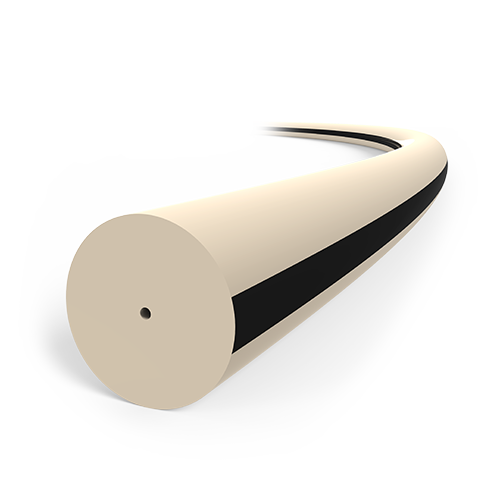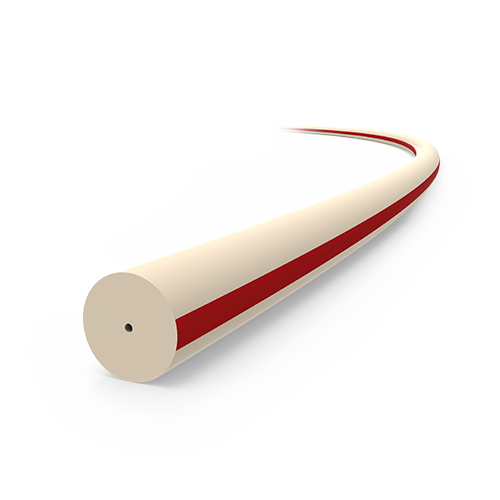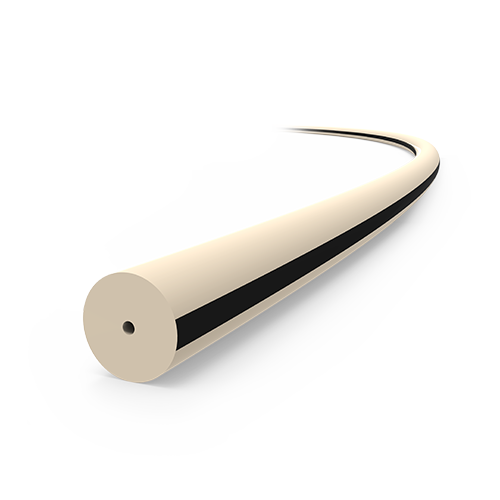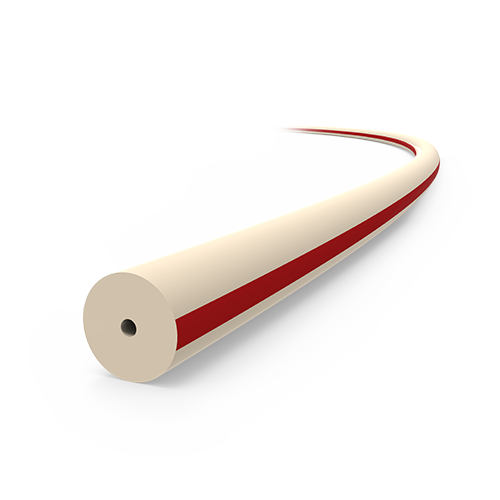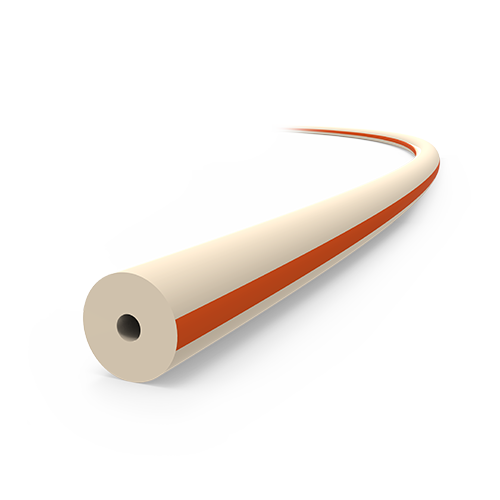Color-coding provides easy identification of the ID of your PEEK tubing – each ID is coded with a different color stripe. PEEK tubing has the strength required to withstand continuous use at HPLC pressure without swelling or bursting, and is not affected by halide salts, high-strength buffers, or other aggressive mobile phases that corrode stainless steel.
The polymer surface will not leach metal ions into the eluent or extract metal-sensitive components from the sample. However, PEEK can be somewhat absorptive of solvents and analytes, notably methylene chloride, DMSO, THF, which may cause swelling. High concentrations of sulfuric and nitric acid will attack PEEK.
Maximum recommended working temp: 100° C (continuous) for 1/16" OD tubing with ID ≤0.75 mm. The high-performance you expect from VICI Jour PEEK tubing, each ID coded with a different colored stripe for easy identification.
Options: Other package sizes and tubing lengths are available. Customized ODs and IDs are available (minimum quantity of 30 meters).
Contact us for more information.
PEEK and Other Polymers
PEEK exhibits excellent resistance to a wide range of organic and inorganic chemicals. The compatibility of PEEK with many chemicals at 20°C (68°F) has been investigated and the results for unreinforced grades are given in the table below.
PEEK is compatible with almost any of the solvents used in HPLC. The only solvents which will attack PEEK are concentrated nitric acid and sulphuric acids. However, PEEK tubing can safely withstand the 20-30% nitric acid used for system passivation.
Methylene chloride, DMSO, and THF may cause swelling in PEEK. The highest temperature we recommend for PEEK is 100°C. Up to that temperature the tubing will maintain the stated pressure rating.
To view polymers' resistance to a chemical, click on the letter that the chemical begins with.
A | B | C | D | E | H | I | K | M | N | P | S | T | W | X
| A |
= |
suitable |
| B |
= |
marginal; dependent on application |
| C |
= |
not recommended |
| – |
= |
no data available |
| Resistance at 20°C |
PEEK |
PE |
PP |
PPS |
FEP |
EFTE |
PFA |
PTFE |
NBR |
EPDM |
| Acetaldehyde |
A |
– |
– |
– |
A |
– |
A |
– |
C |
C |
| Acetic acid (20%) |
A |
A |
A |
A |
A |
A |
A |
A |
B |
A |
| Acetic acid (80%) |
A |
A |
A |
A |
A |
– |
A |
A |
– |
– |
| Acetic acid (glacial) |
A |
A |
A |
A |
A |
A |
A |
A |
C |
A |
| Acetone |
A |
B |
A |
A |
A |
A |
A |
A |
C |
A |
| Acetonitrile |
A |
– |
– |
A |
A |
A |
A |
A |
B |
A |
| Acrylic acid |
A |
– |
– |
A |
A |
– |
A |
– |
– |
– |
| Ammonia, anhydrous |
A |
– |
– |
A |
A |
– |
A |
– |
– |
– |
| Ammonia (10%) |
A |
B |
A |
A |
A |
A |
A |
A |
– |
– |
| Ammonia (liquid) |
B |
– |
– |
A |
A |
– |
A |
– |
– |
– |
| Ammonium hydroxide |
A |
A |
A |
A |
A |
A |
A |
A |
– |
– |
| Aqua regia |
C |
– |
– |
C |
A |
– |
A |
– |
C |
C |
| Aromatic hydrocarbons |
A |
B |
C |
A |
A |
– |
A |
– |
– |
– |
| Resistance at 20°C |
PEEK |
PE |
PP |
PPS |
FEP |
EFTE |
PFA |
PTFE |
NBR |
EPDM |
| Benzene |
A |
B |
C |
A |
A |
A |
A |
A |
– |
– |
| Benzoic acid |
A |
– |
– |
A |
A |
– |
A |
– |
– |
– |
| Benzaldehyde |
A |
– |
– |
A |
A |
– |
A |
– |
– |
– |
| Bromine/dibromoethane |
C |
– |
– |
C |
A |
– |
A |
– |
– |
– |
| Bromine (dry) |
C |
– |
– |
C |
A |
– |
A |
– |
– |
– |
| Bromine (wet) |
C |
– |
– |
C |
A |
– |
A |
– |
A |
A |
| Boric acid |
A |
– |
– |
A |
A |
– |
A |
– |
– |
– |
| Butanol |
A |
A |
A |
A |
A |
A |
A |
A |
– |
– |
| Resistance at 20°C |
PEEK |
PE |
PP |
PPS |
FEP |
EFTE |
PFA |
PTFE |
NBR |
EPDM |
| Calcium hydroxide |
A |
– |
– |
A |
A |
– |
A |
– |
– |
– |
| Carbon tetrachloride |
A |
– |
– |
A |
A |
– |
A |
– |
– |
– |
| Chlorine (gas) |
A |
– |
– |
C |
A |
– |
A |
– |
C |
A |
| Chlorine (liquid) |
C |
– |
– |
C |
A |
– |
A |
– |
– |
– |
| Chloroacetic acid |
A |
B |
B |
A |
A |
A |
A |
A |
– |
– |
| Chlorobenzene |
A |
– |
– |
A |
A |
– |
A |
– |
– |
– |
| Chloroform |
A |
B |
B |
A |
A |
A |
A |
A |
– |
– |
| Cyclohexane |
A |
B |
C |
A |
A |
A |
A |
A |
– |
– |
| Cyclohexanone |
A |
C |
C |
A |
A |
A |
A |
A |
C |
C |
| Resistance at 20°C |
PEEK |
PE |
PP |
PPS |
FEP |
EFTE |
PFA |
PTFE |
NBR |
EPDM |
| Diethylamine |
A |
C |
A |
– |
A |
A |
A |
A |
– |
– |
| Diethylether |
A |
– |
– |
A |
A |
– |
A |
– |
– |
– |
| Diethylformamide |
A |
A |
A |
A |
A |
A |
A |
A |
A |
A |
| Dioxane |
A |
– |
– |
A |
A |
A |
A |
– |
– |
– |
| Resistance at 20°C |
PEEK |
PE |
PP |
PPS |
FEP |
EFTE |
PFA |
PTFE |
NBR |
EPDM |
| Ethanol |
A |
B |
A |
A |
A |
A |
A |
A |
C |
A |
| Ether |
A |
B |
C |
A |
A |
A |
A |
A |
– |
– |
| Ethyl acetate |
A |
B |
A |
A |
A |
A |
A |
A |
A |
A |
| Ethylene chloride |
– |
B |
B |
A |
A |
A |
A |
A |
– |
– |
| Ethlene glycol |
A |
A |
A |
A |
A |
A |
A |
A |
A |
A |
| Resistance at 20°C |
PEEK |
PE |
PP |
PPS |
FEP |
EFTE |
PFA |
PTFE |
NBR |
EPDM |
| Heptane |
A |
B |
B |
A |
A |
A |
A |
A |
A |
A |
| Hexane |
A |
B |
B |
A |
A |
A |
A |
A |
– |
– |
| Hydrobromic acid (20%) |
C |
B |
B |
A |
A |
– |
A |
A |
– |
– |
| Hydrobromic acid (20%) |
C |
B |
A |
– |
A |
A |
A |
A |
– |
– |
| Hydrochloric acid (100%) |
A |
– |
B |
C |
A |
A |
A |
A |
– |
– |
| Hydrochloric acid (20%) |
A |
A |
B |
C |
A |
A |
A |
A |
– |
– |
| Hydrofluoric acid (100%) |
C |
– |
B |
C |
A |
A |
A |
A |
– |
– |
| Hydrofluoric acid (20%) |
– |
A |
A |
A |
A |
A |
A |
A |
– |
– |
| Hydrogen peroxide (100%) |
A |
B |
B |
C |
A |
– |
A |
A |
– |
– |
| Hydrogen peroxide (50%) |
A |
B |
B |
– |
A |
A |
A |
A |
– |
– |
| Hydrogen peroxide (10%) |
A |
A |
A |
A |
A |
A |
A |
A |
– |
– |
| Resistance at 20°C |
PEEK |
PE |
PP |
PPS |
FEP |
EFTE |
PFA |
PTFE |
NBR |
EPDM |
| Iso-octane |
A |
– |
A |
A |
A |
– |
A |
A |
– |
– |
| Isopropanol |
A |
A |
A |
A |
A |
– |
A |
A |
B |
A |
| Isopropyl ether |
– |
A |
B |
– |
A |
– |
A |
A |
– |
– |
| Resistance at 20°C |
PEEK |
PE |
PP |
PPS |
FEP |
EFTE |
PFA |
PTFE |
NBR |
EPDM |
| Ketones |
A |
B |
B |
A |
A |
– |
A |
A |
– |
– |
| Resistance at 20°C |
PEEK |
PE |
PP |
PPS |
FEP |
EFTE |
PFA |
PTFE |
NBR |
EPDM |
| Methanol |
A |
A |
A |
A |
A |
A |
A |
A |
A |
A |
| Methyl dichloride |
– |
– |
C |
– |
A |
– |
A |
– |
– |
– |
| Methyl ethylketone |
A |
B |
B |
A |
A |
A |
A |
A |
– |
– |
| Methlyene chloride |
B |
B |
B |
A |
A |
A |
A |
A |
C |
C |
| Resistance at 20°C |
PEEK |
PE |
PP |
PPS |
FEP |
EFTE |
PFA |
PTFE |
NBR |
EPDM |
| Nitric acid (100%) |
C |
B |
C |
C |
A |
A |
A |
A |
– |
– |
| Nitric acid (20%) |
A |
B |
A |
C |
A |
A |
A |
A |
– |
– |
| Resistance at 20°C |
PEEK |
PE |
PP |
PPS |
FEP |
EFTE |
PFA |
PTFE |
NBR |
EPDM |
| Pentane |
A |
C |
C |
– |
A |
– |
A |
A |
– |
– |
| Perchloric acid |
A |
B |
B |
– |
B |
– |
B |
A |
– |
– |
| Phenol (dilute) |
A |
– |
– |
A |
A |
– |
A |
– |
– |
– |
| Phenol (concentrated) |
C |
– |
– |
A |
A |
– |
A |
– |
– |
– |
| Phosphoric acid (100%) |
A |
B |
A |
A |
A |
A |
A |
A |
– |
– |
| Phosphoric acid (40%) |
A |
A |
A |
A |
A |
A |
A |
A |
– |
– |
| Potassium hydroxide (dilute) |
A |
– |
– |
A |
A |
– |
A |
– |
– |
– |
| Potassium hydroxide (70%) |
A |
– |
– |
A |
A |
– |
A |
– |
– |
– |
| Propanol |
A |
– |
– |
– |
A |
– |
A |
– |
A |
A |
| Pyridine |
A |
B |
A |
A |
A |
A |
A |
A |
– |
– |
| Resistance at 20°C |
PEEK |
PE |
PP |
PPS |
FEP |
EFTE |
PFA |
PTFE |
NBR |
EPDM |
| Sodium hydroxide (80%) |
A |
B |
A |
A |
A |
– |
A |
A |
– |
– |
| Sodium hydroxide (20%) |
A |
A |
A |
A |
A |
A |
A |
A |
– |
– |
| Sulfuric acid (100%) |
C |
B |
B |
A |
A |
A |
A |
A |
– |
– |
| Sulfuric acid (75%) |
C |
A |
A |
A |
A |
A |
A |
A |
– |
– |
| Sulfuric acid (40%) |
A |
A |
A |
A |
A |
A |
A |
A |
– |
– |
| Resistance at 20°C |
PEEK |
PE |
PP |
PPS |
FEP |
EFTE |
PFA |
PTFE |
NBR |
EPDM |
| Tetrahydrofuran |
B |
B |
B |
A |
A |
A |
A |
A |
– |
– |
| Toluene |
A |
B |
B |
A |
A |
A |
A |
A |
– |
– |
| Trichloroacetic acid |
A |
A |
A |
A |
A |
A |
A |
A |
– |
– |
| Trichloroethane |
A |
– |
B |
– |
A |
– |
A |
A |
– |
– |
| Trichloroethylene |
A |
– |
– |
A |
A |
– |
A |
– |
– |
– |
| Triethylamine |
– |
– |
C |
– |
A |
A |
A |
A |
– |
– |
| Resistance at 20°C |
PEEK |
PE |
PP |
PPS |
FEP |
EFTE |
PFA |
PTFE |
NBR |
EPDM |
| Water |
A |
A |
A |
A |
A |
A |
A |
A |
A |
A |
| Water (distilled) |
A |
A |
A |
A |
A |
A |
A |
A |
– |
– |
| Resistance at 20°C |
PEEK |
PE |
PP |
PPS |
FEP |
EFTE |
PFA |
PTFE |
NBR |
EPDM |
| Xylene |
A |
– |
– |
A |
A |
– |
A |
– |
– |
– |
Chemical Resistance of PEEK at High Temperature
| A |
= |
suitable |
| B |
= |
marginal; dependent on application |
| C |
= |
not recommended |
| Chemical |
Temperature |
Rating |
| Acetic acid |
200°C (420°F) |
B |
| Ammonia gas |
200°C (420°F) |
A |
| Carbon monoxide gas |
200°C (420°F) |
A |
| Ethylene glycol |
200°C (420°F) |
B |
| Ethylene glycol (50%) |
140°C (284°F) |
A |
| Hydrogen sulphide gas |
200°C (420°F) |
A |
| Liquid ammonia |
200°C (420°F) |
B |
| Methane |
200°C (420°F) |
A |
| Methylethylketone |
200°C (420°F) |
C |
| Nitrobenzene |
200°C (420°F) |
C |
| Phosphoric acid (50%) |
200°C (420°F) |
A |
| Sodium hydroxide solution |
200°C (420°F) |
A |
| Sulphuric acid (50%) |
200°C (420°F) |
B |
| Sulphur dioxide gas |
200°C (420°F) |
A |
Use the chart below to determine the volume per length of tubing, based on the inside
dimension (ID). Note that VICI Jour 1/16" OD tubing typically has an ID
tolerance of ±.001". This is a much tighter tolerance than normal commercial grades of tubing; however, it is
enough to result in noticeable error if exact volumes are not measured.
| Tubing ID |
Volume/length |
| mm |
Inches |
µl/cm |
µl/in |
| 0.050 |
.002" |
0.02 |
0.05 |
| 0.064 |
.0025" |
0.03 |
0.08 |
| 0.075 |
.003" |
0.04 |
0.12 |
| 0.10 |
.004" |
0.08 |
0.21 |
| 0.13 |
.005" |
0.13 |
0.32 |
| 0.17 |
.0067" |
0.23 |
0.58 |
| 0.18 |
.007" |
0.25 |
0.63 |
| 0.25 |
.010" |
0.51 |
1.29 |
| 0.38 |
.015" |
1.14 |
2.90 |
| 0.50 |
.020" |
2.03 |
5.15 |
| 0.64 |
.025" |
3.17 |
8.04 |
| 0.75 |
.030" |
4.56 |
11.58 |
| 1.00 |
.040" |
8.11 |
20.59 |
| 1.40 |
.055" |
15.39 |
38.93 |
| 1.52 |
.060" |
18.24 |
46.33 |
| 1.59 |
.062" |
19.86 |
49.47 |
| 1.65 |
.065" |
21.38 |
54.38 |
| 1.70 |
.067" |
22.70 |
57.78 |
| 1.78 |
.070" |
24.83 |
63.06 |
| 2.00 |
.079" |
31.42 |
80.32 |
| 2.10 |
.083" |
34.64 |
88.66 |
| 2.16 |
.085" |
36.61 |
92.99 |
| 2.40 |
.094" |
45.24 |
113.72 |
| 3.18 |
.125" |
79.4 |
201 |
| 3.76 |
.148" |
111 |
282 |
| 4.35 |
.171" |
149 |
376 |
All polymers used in the manufacture of VICI Jour tubing are EU CIRS-REACH compliant. Additionally, all colorants used comply with RoHS(Restriction of Hazardous Substances)



